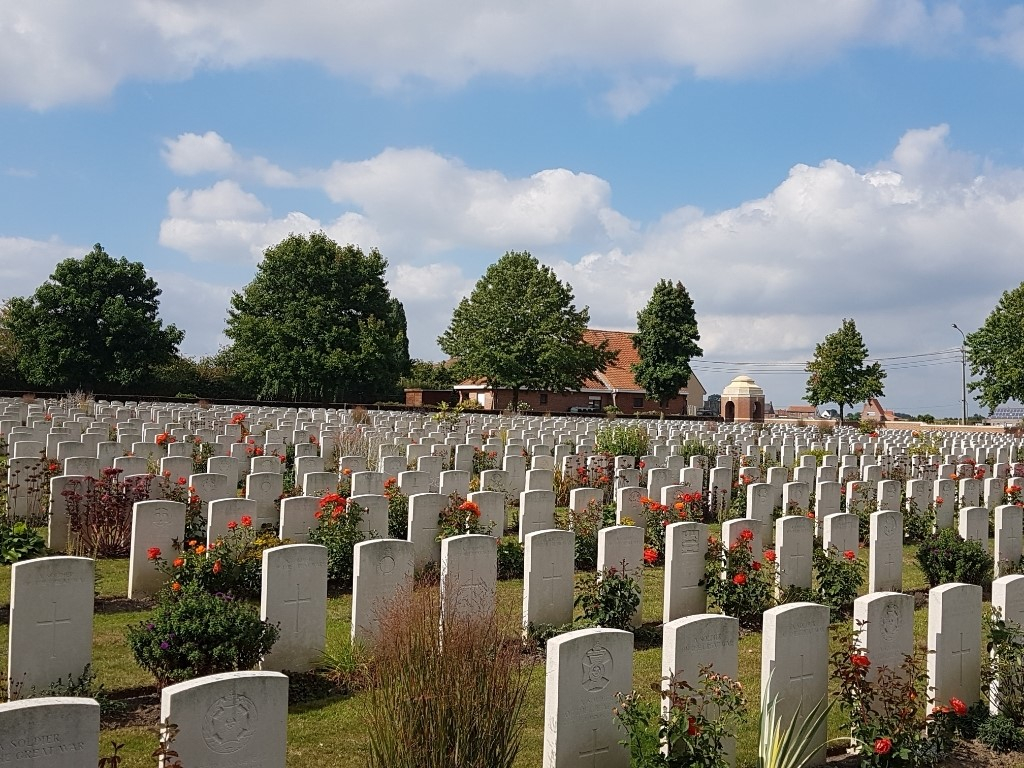Cement House Cemetery
- Country Belgium
- Total identified casualties 1188 Find these casualties
- Region West-Vlaanderen
- Identified casualties from First & Second World War
- GPS Coordinates Latitude: 50.905, Longitude: 2.90694
Location information
Cement House cemetery is located in Langemark which is located north of the town of Ieper off the N313. From the Markt take the Korte Ieperstraat, at the end turn right into Boezingestraat, past the first turning on the left and the cemetery is 100 metres on the left hand side.
Visiting information
Wheelchair access is possible via the main entrance. There are turf ramps to both the left and right immediately inside the main entrance which are suitable for wheelchair access.
For further information regarding wheelchair access, please contact our Enquiries Section on telephone number: 01628 507200
History information
Langemark has given its name to the Battles of 21-24 October 1914 and 16-18 August 1917. The village was in German hands from April 1915 to August 1917 and from April to September 1918. Commonwealth, French and Belgian forces have in turn defended and attacked it.
"Cement House" was the military name given to a fortified farm building on the Langemark-Boesinghe (now Boezinge) road. The original Cement House Cemetery (now Plot I, an irregular group of 231 graves) was begun here at the end of August 1917 and used by the 4th and 17th Division burial officers, by field ambulances and by units in the line until April 1918.
In the years immediately following the Armistice, most of Plots II - XV were added when Commonwealth graves were brought in from the battlefields and small burial grounds around Langemark and Poelkapelle, mostly dating from the Autumn of 1917. The more important graveyards or groups of graves concentrated into this cemetery were the following:-
ASQUILLIES CHURCHYARD, which contained the graves of eleven British soldiers of November 1918.
AUDREGNIES CHURCHYARD, which contained the graves of eight British soldiers of August 1914 and one of November 1918.
ELVERDINGHE CHURCHYARD, which contained the graves of nine British soldiers of October 1914.
HENSIES CHURCHYARD, which contained the graves of one Canadian and three British soldiers of November 1918 and one British soldier of August 1914.
HEULE CHURCHYARD, which contained the graves of six British soldiers and one unidentified airman buried in October 1918.
MAISIERES COMMUNAL CEMETERY, which contained the graves of sixteen British soldiers of August 1914.
MEERENDRE CHURCHYARD, which contained the graves of four R.A.F. officers buried in October 1918.
OOSTNIEUWERKE CHURCHYARD, which contained the graves of five Canadian and five British soldiers of April 1915 and one British officer of October 1914.
PHEASANT TRENCH CEMETERY, LANGEMARCK, was in the fields a little East of Langemarck village. Pheasant Trench and Pheasant Farm were taken by the 51st (Highland) Division on the 20th September, 1917, but the cemetery was begun two months later. It contained the graves of fourteen soldiers from the United Kingdom.
PROVEN CHURCHYARD, which contained the graves of one Canadian officer and three British soldiers.
QUAREGNON COMMUNAL CEMETERY, which contained the graves of eight British soldiers buried in 1914.
ROLLEGHEM CHURCHYARD, which contained the graves of one R.A.F. officer and four British soldiers buried in 1918.
THULIN NEW COMMUNAL CEMETERY, which contained the graves of eight British soldiers of August 1914 and two R.A.F. officers of October 1918.
WINKEL ST. ELOI CHURCHYARD, which contained the graves of thirty British and four Newfoundland soldiers buried in October 1918.
Plots XVI, XVII and XVIII originally contained some 500 French graves, but these were removed in 1922. The space vacated has been filled in over the intervening years by graves brought in from communal cemeteries and churchyards in the area, when their maintenance in these locations could no longer be assured. The cemetery is still used for the burial of remains that continue to be discovered in the vicinity, and a number of plots have been extended to accommodate these graves.
There are now 3,592 Commonwealth servicemen of the First World War buried or commemorated in the cemetery, 2,425 of the burials are unidentified.
Of the 22 Second World War burials in the cemetery, five are unidentified.
The cemetery was designed by Sir Reginald Blomfield.



